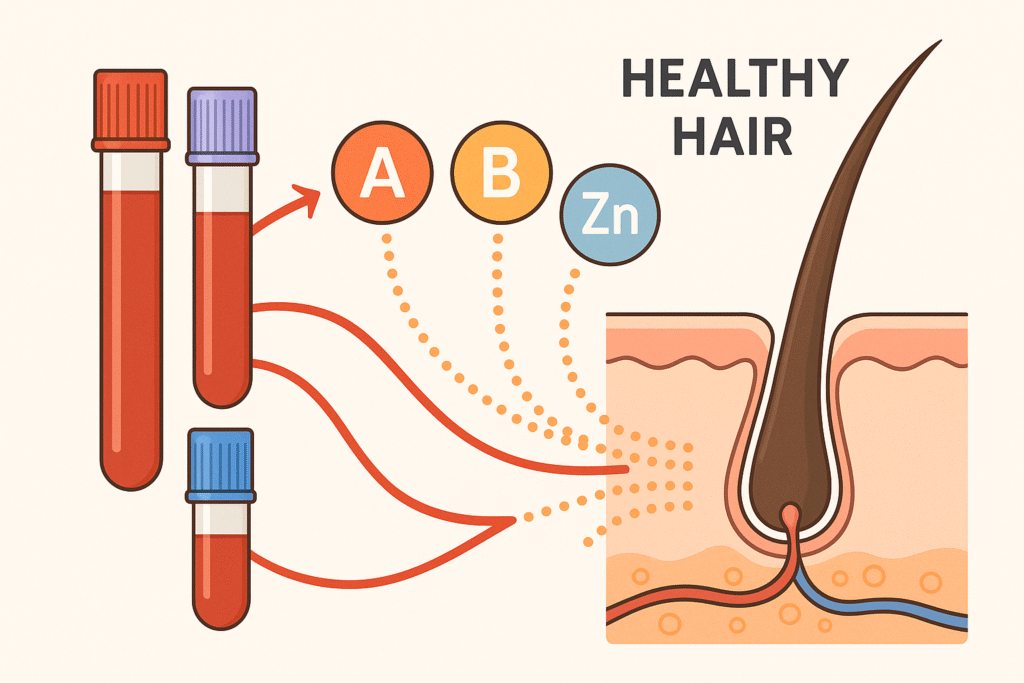The Battle of the Hair Loss Champions:
Finasteride vs. Dutasteride – Millions of men grapple with hair loss, a condition that can significantly impact self-esteem and confidence. Fortunately, two medications have emerged as powerful allies in the fight against male pattern baldness: finasteride and dutasteride. Both belong to a class of drugs called 5-alpha reductase inhibitors (5ARIs), which work by reducing levels of dihydrotestosterone (DHT), a hormone that contributes to hair loss.
But which one is right for you?
This comprehensive guide will delve into the similarities and differences between finasteride and dutasteride, examining their effectiveness, side effects, and suitability for different individuals. By the end, you’ll be equipped with the knowledge to make an informed decision about which medication may be the best fit for your hair restoration journey.

Table of contents
- The Battle of the Hair Loss Champions:
- But which one is right for you?
- What are Finasteride and Dutasteride?
- How They Work to Combat Hair Loss:
- Key Differences Between Finasteride and Dutasteride
- Which Medication is More Effective?
- Hair Regrowth Potential: What to Expect
- Common Side Effects:
- Rare But Serious Side Effects:
- Which Medication is Safer?
- Scientific Studies & Review Articles
- Other Resources:
- Hair Loss GP Related Links
Understanding the Basics:
What are Finasteride and Dutasteride?
Both finasteride (brand name Propecia) and dutasteride (brand name Avodart) are oral prescription medications that belong to the 5-alpha reductase inhibitor (5ARI) class. They work by inhibiting the 5-alpha reductase enzyme, which converts testosterone into DHT.
How They Work to Combat Hair Loss:
DHT is a hormone that plays a crucial role in male pattern baldness. It miniaturises hair follicles, causing them to shrink and produce thinner, weaker hair strands until they eventually stop growing altogether. Both finasteride and dutasteride work by blocking the 5-alpha reductase enzyme, thereby reducing DHT levels and slowing down or even reversing hair loss.
Key Differences Between Finasteride and Dutasteride
While both medications function similarly, there are notable differences:
- Potency: Dutasteride is a more potent 5ARI than finasteride. It inhibits both type 1 and type 2 of the 5-alpha reductase enzyme, while finasteride primarily targets type 2. This means that dutasteride can reduce DHT levels more effectively than finasteride.
- Effectiveness: While both medications have been proven effective in treating hair loss, some studies suggest that dutasteride may be more effective in promoting hair regrowth and increasing hair count due to its stronger DHT inhibition. However, more research is needed to definitively confirm this.
- Usage: Finasteride is specifically approved by the FDA for treating male pattern baldness, while dutasteride is primarily approved for treating enlarged prostate (benign prostatic hyperplasia or BPH). However, dutasteride is often prescribed off-label for hair loss due to its effectiveness.
Recommended Read
Effectiveness for Hair Loss:
Both finasteride and dutasteride have been extensively studied for their effectiveness in treating hair loss. Clinical trials have consistently shown that both medications can:
- Slow or Stop Hair Loss: Both medications have been shown to slow or stop hair loss in a significant percentage of men.
- Promote Hair Regrowth: A substantial number of men experience visible hair regrowth, particularly in the crown area, after several months of consistent use.
- Increase Hair Count and Thickness: Both medications can lead to an increase in hair count and hair thickness, resulting in a fuller appearance.
Which Medication is More Effective?
While both finasteride and dutasteride are effective, some studies suggest that dutasteride may be more effective in promoting hair growth due to its stronger DHT inhibition. A 2014 study published in the Journal of the American Academy of Dermatology found that dutasteride 0.5mg led to a greater increase in hair count compared to finasteride 1mg after 24 weeks of treatment. However, more research is needed to conclusively determine which medication is superior in terms of long-term efficacy.
Hair Regrowth Potential: What to Expect
The extent and speed of hair regrowth can vary among individuals, depending on factors like age, hair loss severity, and individual response to treatment. Generally, you can expect to see noticeable improvements within 6-12 months of consistent use. The most common areas of improvement are the crown and vertex of the scalp. However, it’s important to remember that neither medication can regrow hair in areas where follicles have completely miniaturised and ceased to function.
Side Effects and Safety:
Both finasteride and dutasteride share similar potential side effects, but the incidence and severity may vary slightly.
Common Side Effects:
- Sexual Side Effects: The most common side effects are sexual in nature and include decreased libido, erectile dysfunction, and changes in ejaculation (such as decreased volume). These side effects are usually mild and often resolve over time.
- Breast Tenderness or Enlargement: A small percentage of men may experience breast tenderness or enlargement. This side effect is usually temporary and reversible upon discontinuation of the medication.
Rare But Serious Side Effects:
- Allergic Reactions: In rare cases, both medications can cause allergic reactions, such as rash, itching, hives, or difficulty breathing. Seek medical attention immediately if you experience any of these symptoms.
- Depression and Anxiety: Although rare, some men may experience mood changes, including depression and anxiety, while taking finasteride or dutasteride.
- Liver Problems: Dutasteride may rarely cause liver problems. Your doctor may monitor your liver function with blood tests if you take this medication.
Which Medication is Safer?
Both finasteride and dutasteride are generally considered safe when taken as directed and under medical supervision. However, due to its higher potency, dutasteride may have a slightly increased risk of side effects compared to finasteride. It’s essential to weigh the potential benefits against the risks and discuss any concerns with your doctor. They can help you determine which medication is the safer and more suitable option for your individual situation.
Section 5: Who Should Choose Finasteride vs. Dutasteride?
The choice between finasteride and dutasteride depends on various factors, including:
- Age: Younger men may be better candidates for dutasteride as they tend to have higher DHT levels and may benefit from its stronger inhibition.
- Hair Loss Severity: For mild to moderate hair loss, finasteride may be a suitable option. However, for more extensive hair loss or when maximum DHT reduction is desired, dutasteride might be preferred.
- Medical History: If you have a history of prostate problems or are taking certain medications, your doctor may recommend one medication over the other based on potential interactions and risks.
- Tolerance to Side Effects: Individual responses to side effects can vary. If you’re concerned about potential sexual side effects, your doctor may suggest starting with finasteride, which is generally associated with a lower incidence of these side effects.
- Cost: Generic finasteride is typically more affordable than dutasteride. However, the cost difference may not be significant for some individuals.
Individualised Treatment Plans: The best way to determine which medication is right for you is to consult with a hair loss specialist. They can assess your individual needs, goals, and medical history to create a personalised treatment plan tailored to you.
Section 6: Combination Therapy and Alternatives
- Can Finasteride and Dutasteride Be Used Together? While it’s technically possible to use both medications together, it’s generally not recommended due to the potential for increased side effects and lack of substantial additional benefits. Combining either medication with topical minoxidil is often a more effective strategy.
- Other Hair Loss Treatment Options: In addition to finasteride and dutasteride, other hair loss treatment options include:
- Minoxidil: A topical solution that stimulates hair growth and can be used alone or in combination with oral medications.
- Hair Transplant Surgery: This surgical procedure involves transplanting hair follicles from one area of the scalp to another.
- Platelet-Rich Plasma (PRP) Therapy: PRP involves injecting a concentrated solution of your own platelets into the scalp to promote hair growth.
- Low-Level Laser Therapy (LLLT): This therapy uses red light to stimulate hair follicles and promote hair growth.
- Choosing the Best Approach for Your Hair Restoration Journey: The ideal treatment for you will depend on your individual needs and preferences. It’s crucial to consult with a hair loss specialist to discuss all available options and develop a personalised treatment plan that aligns with your goals and lifestyle.
Conclusion
Choosing between dutasteride and finasteride involves a thorough evaluation of individual factors, including the severity of hair loss, medical history, potential side effects, and cost. Consulting with a healthcare professional is essential for making an informed decision and developing a personalised treatment plan to address your specific hair loss concerns. Remember, both medications require ongoing use to maintain results, and it’s important to manage expectations and be patient as you monitor your progress.
Finasteride Vs Dutasteride FAQ
While some studies suggest dutasteride may be more effective due to its greater inhibition of DHT, the hormone responsible for hair loss, individual responses can vary. It’s essential to consult with a hair loss specialist to determine which medication is best suited for your specific needs and goals.
Yes, dutasteride and minoxidil can be used together and often complement each other’s effects for more comprehensive hair loss treatment. Minoxidil stimulates hair growth topically, while dutasteride works internally to reduce DHT levels.
While dutasteride is generally considered safe for long-term use when taken as directed and monitored by a doctor, regular checkups and blood tests are recommended to monitor for potential side effects or interactions with other medications.
The most common side effects are sexual in nature, such as decreased libido, erectile dysfunction, and changes in ejaculation. These are usually mild and often resolve over time. Other potential side effects include breast tenderness or enlargement.
In most cases, side effects associated with dutasteride are temporary and resolve after stopping the medication. However, discussing any concerns with your doctor is crucial for personalized advice.
No, dutasteride is not recommended for women, especially those who are pregnant or may become pregnant. It can cause harm to a developing male fetus. Pregnant women should avoid handling dutasteride.
Noticeable results typically take 3-6 months of consistent use. Continued use is necessary to maintain any hair regrowth achieved.
Yes, if you discontinue dutasteride, your hair loss will likely resume, and any hair regrowth gained may be lost over several months.
Dutasteride, particularly the brand-name Avodart, can be more expensive than finasteride. However, generic versions of dutasteride are available at a lower cost.
Yes, other options include minoxidil, hair transplant surgery, platelet-rich plasma (PRP) therapy, and low-level laser therapy (LLLT). It’s important to consult with a hair loss specialist to determine the best approach for you based on your individual needs and preferences.
External Sources
Scientific Studies & Review Articles
Medical Citations on Dutasteride for Hair Loss:
Medical Citations and URLs for Dutasteride vs Finasteride:
- J Am Acad Dermatol: A randomised clinical trial comparing the efficacy and safety of dutasteride 0.5 mg and finasteride 1 mg in men with androgenetic alopecia.
- Indian Dermatol Online J: A randomised, active-controlled, blinded clinical trial of the efficacy and tolerability of dutasteride versus finasteride in the treatment of male androgenetic alopecia.
- JAMA Dermatol: Dutasteride 0.5 mg/d vs finasteride 1 mg/d in the treatment of male pattern hair loss: A meta-analysis of randomised controlled trials.
- Int J Trichology: Efficacy and safety of dutasteride 0.5 mg once daily vs. finasteride 1 mg once daily in the treatment of male subjects with androgenetic alopecia: A randomised, double-blind, placebo-controlled study.
These studies and reviews provide insights into the comparative effectiveness and safety of dutasteride and finasteride for androgenetic alopecia.
Other Resources:
Official Medication Websites:
- Propecia (Finasteride)
- Avodart (Dutasteride):
Medical Information Websites:
Other Resources:
- National Institutes of Health (NIH)
- American Hair Loss Association
Please note: It’s important to consult with your doctor or a healthcare professional before starting any new medication for hair loss.












